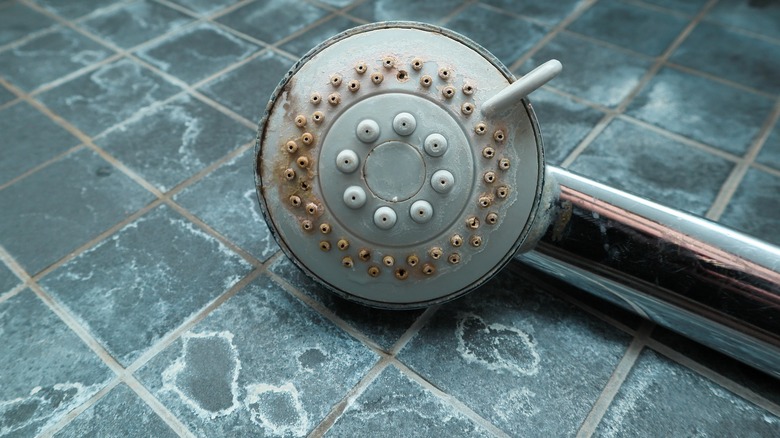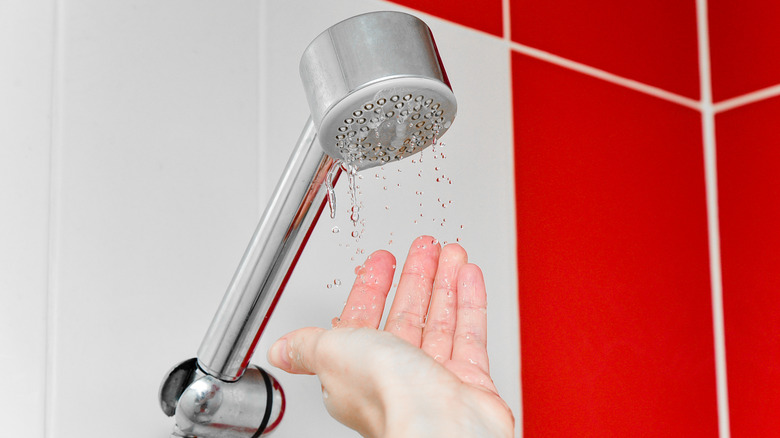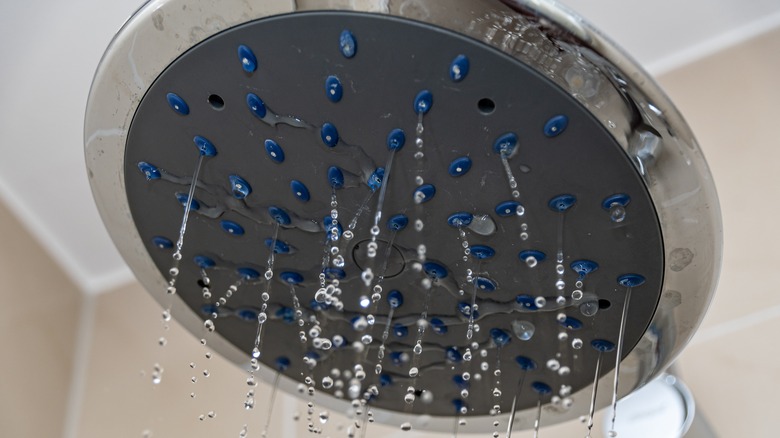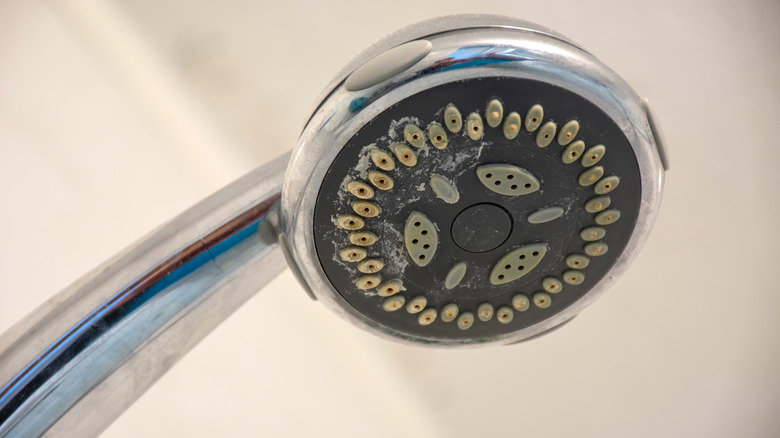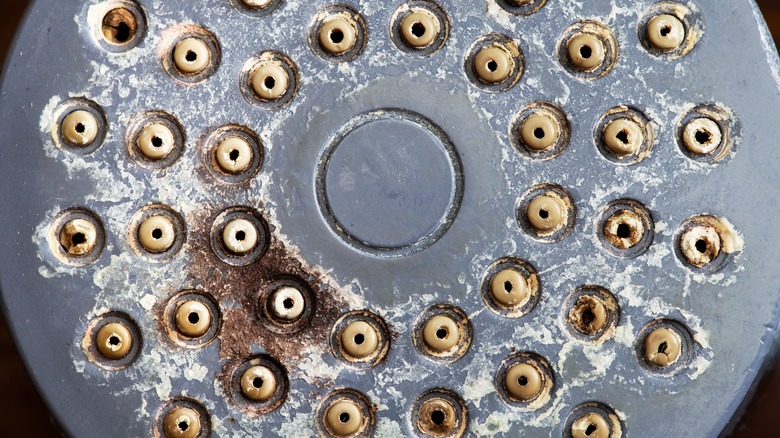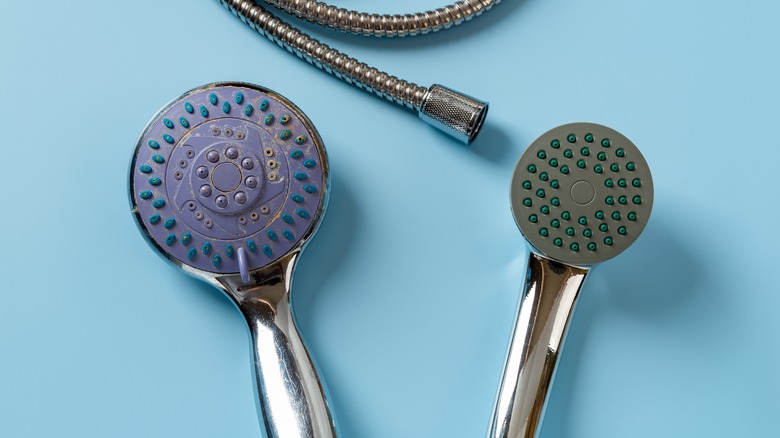You Need To Clean Your Shower Head If You Notice Any Of These Signs
Your shower head must be practically self-cleaning, right? At least on the inside, after all, it's constantly using water — the same water you use to clean yourself. Unfortunately, other things use the same water, especially warm water, which aren't so pleasant. Research from various universities has identified microorganisms in shower heads and hoses that cause conditions like Legionella; ear, eye, and scalp infections; non-tuberculosis mycobacteria-related lung disease; Strep, Staph, and E. coli infections; and Crohn's Disease. Under the right (or perhaps we should say "wrong") conditions, these can be aerosolized by the shower head ... meaning that you end up inhaling them. Other, usually more likely, problems include uneven shower water pressure and a general feeling of disgust.
Fear not, though. Most of these are readily addressed, and the signs are obvious, including visible buildup on the shower head, irregular spray patterns, and funky smells. Still, others, like the microorganisms from biofilms in shower hoses — which are impractical to clean regularly — make it a good idea to replace your shower head periodically. In the meantime, however, we'll show you how to give it a good clean between replacements.
Weak water pressure may indicate a clogged shower head
Weak water pressure in the shower is a singularly unsatisfying experience, and it's worse when you recognize that it's probably caused by a dirty shower head. Water pressure is impacted by many factors, including the buildup of mineral deposits and organic material inside the shower head's ports. If the low water pressure is irregular -– that is, if it's sometimes okay and other times not — it might not be a partial blockage. But if the shower head's performance is in decline, your best bet is to give it a deep cleaning. Pressure problems can also be caused by normal wear to the components of the shower, in which case a replacement is in order. It's also important to know how often you should replace your shower head filter if your shower has one.
It varies depending on how your shower head is made, but the basic cleaning procedure is to soak the business end of your shower head in vinegar. It might be tempting, but cleaning your shower head with bleach is a bad idea. If your shower head can be removed and disassembled, soak the parts in a solution of water and vinegar overnight – then rinse thoroughly and reattach. If yours can't be removed, pour vinegar into a plastic bag and secure it around your shower head using a cable tie or string. After soaking, clean the water ports with a soft toothbrush to dislodge any remaining limescale.
Clean your shower head when you get inconsistent water spray patterns
Another common sign your shower head needs cleaning is when shower jets seem to spray in random directions with inconsistent pressure, usually a chaotic combination of sprays that hit everything and don't clean much of anything. This is almost certainly caused by minerals you can remove very easily with a good cleaning, and you don't even need to introduce a soup of toxic cleaning chemicals to your shower.
When the problem is caused by mineral buildup, the quick fix is the same as for water pressure issues: remove the shower head, if possible, and clean it with vinegar. If you have a severe hard water problem, it could be time to address the problem at its source by installing a whole-house water softener that replaces scale-causing calcium and magnesium in your water with sodium and potassium, stopping scale deposit on plumbing fixtures.
When you see mineral buildup, it's time to clean your shower head
Sometimes, mineral buildup makes your water pressure decline or your shower spray itself go haywire, but you might see it long before either of those things happens. Rust, limescale, and other mineral deposits are very common, even on shower heads that aren't coping with hard water. Visible deposits are often easily cleaned with vinegar but might be caused by a problem that goes beyond routine cleaning.
Occasionally, these buildups are caused by sediment from your water heater. It's usually easier to identify the sediment problem if you don't experience it at all on fixtures like pot fillers that don't have a hot water connection. Flushing your hot water tank doesn't require a plumber if you prefer to deal with it yourself. Turn off the electricity via your circuit breaker panel or the nearby disconnect. If you have a gas water heater, set it to the pilot setting. Turn on a hot water tap somewhere in your home, then turn off the cold water line that feeds the heater. Attach a hose to the drain spigot, open the spigot, and drain into a bucket, using a pump if necessary. Turn off the spigot, turn on the cold-water line, and repeatedly fill and flush the heater into your bucket until the water runs clear. Finally, turn off the spigot, turn on the cold water, turn off your hot water faucet, and turn the power or gas back on.
Funky smells? Clean your shower head
Here's what you might have in common with mold: you both enjoy a nice, warm shower. The University of Colorado found Mycobacterium avium ("Mycobacterium" indicates a microorganism originating from fungi like mold) in 30 percent of the shower heads it tested. M. avium is linked to pulmonary disease, so it's not what you want to be breathing in the shower. You can usually, but not always, see mold as well. Mold requires a constant source of water, which makes bathrooms — with their tubs, showers, toilets, sinks, and high humidity — a perfect place for it to grow.
Molds, even panic-inducing black mold, can easily be removed from non-porous surfaces like shower heads with a wipe-down using water and detergent. However, it might be worthwhile to simply replace the shower head, depending on its age. The University of Manchester found a number of bacteria in the hoses that feed shower heads, including Legionella, which can cause a sulfurous smell. Replacing the shower head assembly, hoses included, is obviously simpler than wiping down a shower head and cleaning inside hoses, and if it's time to replace the unit, this would be a good time to do it. Based on reviews, the top three Home Depot shower heads cost between $25 and $123.
Clean your shower head when it's time
So, when is it time to replace a shower head, and when is it time for routine cleaning? The frequency with which you replace your shower head depends on the head you have. Some say it'll need replacing as often as once a year (or even more often) if you have consistent water quality problems. However, others say investing in a high-quality shower head will give you up to 15 years before a replacement is needed. Cleanings should happen once a month, but less is fine if you don't experience any of the signs discussed above. If you have hard water, you might want to set the clock a little more frequently. Given the nature of buildup (of grime, minerals, or mold), the more often you do these regular cleanings, the less often you'll have to take everything apart for deep cleaning.
Elaborate, expensive, or unusual shower head assemblies are often impractical to replace every six months, as some experts recommend. Disassembly and deep cleaning can obviously prolong the life of your shower head, and it is possible to clean shower hoses as well. In fact, the process is pretty much the same as for routine shower head cleanings: soak in a solution of vinegar and warm water, then scrub the parts you can get to with a soft brush. Rinse and repeat every month or so.
